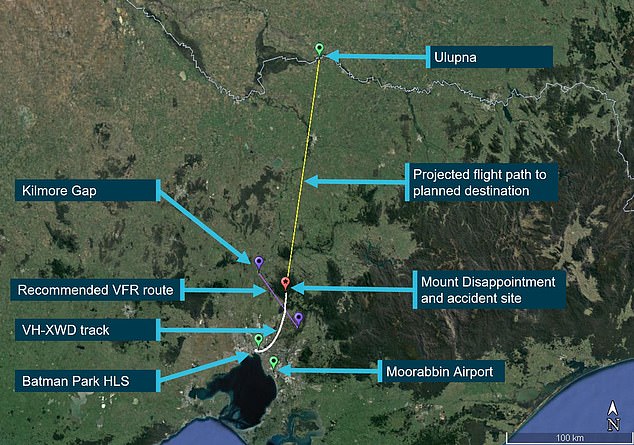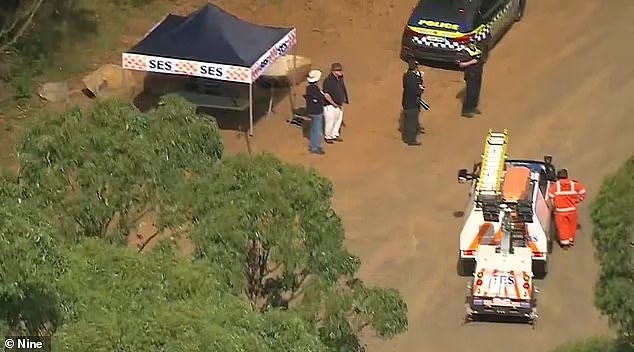Mount Disappointment crash: Crucial reason why chopper pilot Dean Neal who crashed into a mountain killing all five on board ‘should not have been flying’ that day
A report detailing the final moments of a pilot and four helicopter passengers killed when it crashed into a mountain found that the man at the controls was not prepared to fly under the conditions.
The Australian Transport Safety Bureau (ATSB) on Thursday released its findings into the crash at Mount Disappointment, north of Melbourne, on March 31, 2022.
The nearly two-year investigation found that pilot Dean Neal should not have flown that day because he had not been trained in safe flying while using only the helicopter’s instruments.
The 32-year-old was piloting the helicopter on a flight from Melbourne to Ulupna when he was forced to make an emergency turn to avoid a ‘wall of cloud’ that quickly enveloped the aircraft and caused him to lose sight of the ground. .
Due to Mr. Neal’s lack of experience with the scenario, the plane descended rapidly before crashing into a tree and then into the dense forest.
The crash killed both Mr Neal and the passengers Nicholas Vasudeva, co-founder of First AG Capital, Linda Woodford, the founder of AXIchain, financial advisor Ian Perry and meat industry magnate Paul Troja.
A report into a helicopter crash that killed five people, including pilot Dean Neal (pictured), found the 32-year-old had no training to fly in the rough conditions
Mr Neal had held his commercial pilot’s license since 2016 and flew sightseeing flights over tourist hotspots such as Ayers Rock and Hamilton Island.
He was also trained to provide specialist support to aerial bushfires and patrolled beaches on behalf of Surf Life Saving Victoria.
Despite his previous qualifications, the report found that Mr Neal had no experience in ‘instrument flying, simulated instrument flying or night flying’.
Another pilot flying the same flight path alongside Mr Neal, named WVV, was also found to have ‘no instrument or night flying experience’.
Even though both pilots knew bad weather was coming along the way, they flew anyway despite not being trained for the conditions.
As the helicopters approached Mount Disappointment, layers of cloud above and below them began to gather in front of them.
Both pilots felt confident to continue because WVV, who was sitting in front of Neal, “saw spots of sun falling on the ground,” meaning the clouds had broken.
WVV was forced to make an emergency turn as the clouds quickly crashed onto the helicopters instead.
After successfully executing the maneuver, the pilot saw Mr. Neal’s helicopter fly past him on a path toward the clouds and the doom of all on board.
The descent rate was so aggressive that the crash occurred just 30 seconds after Neal began the U-turn.

Mr Neal and the pilot of another helicopter decided to risk flying through cloud over Mount Disappointment on March 31, 2022, before Mr Neal’s plane crashed (flight path shown)

He attempted an emergency turn using only the helicopter’s instruments, resulting in a rapid descent before crashing (photo, police on scene)
The report notes that it is not a requirement to have completed instrument flight training to hold a helicopter license, although this is strongly recommended.
Without forcing their pilots to undergo instrument flight training, the pilots’ employer, Microflite Helicopter Services, “relied on individual pilots to identify the need and develop their own procedure” that would save them.
“Providing this procedure and training would have reduced the risk of loss of postural control following an IIMC encounter (unintentional IMC),” the report said.
‘The operator had also not implemented an IIMC recovery procedure for its air transport operations, or a pre-flight risk assessment to initiate an escalation process for marginal weather conditions identified during the pre-flight planning phase.’
Although Microflite offered to train its pilots in IIMC procedures, the report found that neither Mr. Neal nor WVV had done so.
Microflite has since introduced a series of safety protocols, including the addition of autopilots and other flight instrument upgrades to their fleet.
The company is also making it mandatory for all its pilots to complete IIMC training and has purchased two ‘hoods’ that ‘enhance transition training from visual to instrument flight conditions’ by obstructing their vision.
